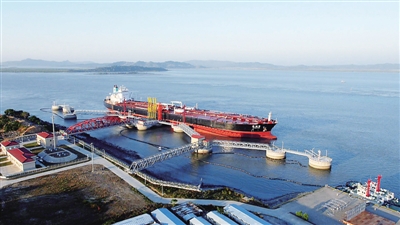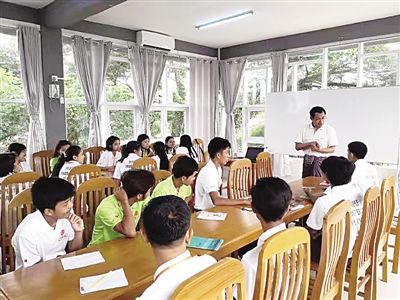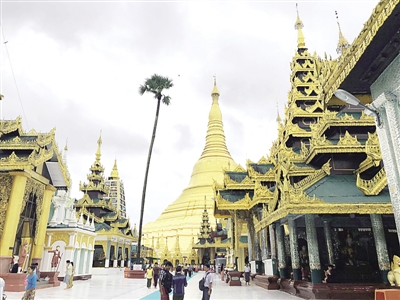Major cooperation releases Huimin dividend! China-Myanmar economic corridor opens for construction.

Oil tankers of China-Myanmar oil and gas pipeline project unload crude oil at the dock of Made Island in Kyaukphyu. Photo courtesy of Lucheng

In September 2019, CITIC Group launched an English education public welfare activity in Kyaukphyu. Photo courtesy of Lucheng

Shwedagon Pagoda and its surrounding temples in Yangon. Photo by deer/bright picture
[Special attention]
On January 18th, during his visit to Myanmar, the Supreme Leader of president and Senior Minister Aung San Suu Kyi witnessed the agreement exchange ceremony of the deepwater port project in Kyaukphyu Special Economic Zone, marking the transition from concept to substantive planning and construction stage of the China-Myanmar economic corridor under the framework of the Belt and Road Initiative.
Since the establishment of diplomatic relations between China and Myanmar, the economic and trade cooperation between the two countries has been developing continuously on a long-term and close basis. China’s accumulated investment in Myanmar has reached 20.8 billion US dollars, accounting for about a quarter of Myanmar’s total foreign investment, second only to Singapore. In the field of trade, China is Myanmar’s largest trading partner, and China-Myanmar border trade accounts for nearly 80% of Myanmar’s total border trade. With the proposal of the China-Myanmar Economic Corridor and the construction and operation of landmark projects along the route, the cooperation and exchange between China and Myanmar has moved to a new stage of closer cooperation. The "Belt and Road" cooperation of mutual cooperation, sharing and joint construction has promoted mutual benefit and win-win situation between the two countries.
High-level exchanges consolidate the intention of cooperation and development
On the morning of January 18th, when the Supreme Leader of president held formal talks with Senior Minister Aung San Suu Kyi of Myanmar in Naypyidaw, he pointed out that the two sides should promote the five-year plan of economic and trade cooperation between the two countries, effectively align their development strategies, and implement the economic, trade and capacity cooperation between the two countries. The construction of the China-Myanmar Economic Corridor is the top priority for the two sides to jointly build the "Belt and Road". The two sides have started the substantial construction of the China-Myanmar Economic Corridor, and it is necessary to improve the sense of gain of the two peoples, especially the Burmese people, as soon as possible.
In November 2017, China proposed to build a "herringbone" China-Myanmar economic corridor, starting from Yunnan, China in the north, passing through the China-Myanmar border to Mandalay in the south, and then extending to Yangon New Town and Kyaukphyu Special Economic Zone in the east and west respectively, connecting the most backward areas and the most developed areas in Myanmar, and creating a large-scale cooperation pattern with three-pronged support and three pillars. As an important part of the Belt and Road Initiative, the China-Myanmar Economic Corridor has become the second time that China has proposed to establish an economic corridor with a single country after proposing the "six major economic corridors".
In September 2018, China and Myanmar signed a memorandum of understanding to jointly build the China-Myanmar Economic Corridor, established the China-Myanmar Economic Corridor Joint Committee, and set up 12 working groups according to industries. In December of the same year, Myanmar established the "One Belt, One Road" Implementation Leading Committee, with Senior Minister Aung San Suu Kyi as the chairman and First Vice President Min Rui as the vice chairman. The members of the Committee include several federal government ministers and provincial and state chief ministers, aiming at actively promoting the construction of China-Myanmar economic corridor, deepening mutually beneficial cooperation in various fields and promoting the development of China-Myanmar comprehensive strategic cooperative partnership. On February 18, 2019, Myanmar’s "One Belt, One Road" Implementation Leading Committee held its first meeting. At the meeting, Aung San Suu Kyi, Chairman of the Committee and Senior Minister of State, said that the "One Belt, One Road" initiative not only covers infrastructure construction, but also covers a wide range of fields. Myanmar is located along the "Belt and Road", which is a beneficial opportunity for Myanmar and the whole region to participate in the "Belt and Road".
During the second meeting of the China-Myanmar Economic Corridor Joint Committee and the second China-Myanmar Economic Corridor Forum on February 21-22, 2019, China proposed 24 projects according to the China-Myanmar Economic Corridor Plan, and Myanmar agreed to speed up the work of 9 projects, including Kyaukphyu Special Economic Zone, Kachin State and Shan State Border Trade Zone. In the future, the construction of China-Myanmar Economic Corridor will be coordinated with the Myanmar 2030 Sustainable Development Plan, covering electricity, roads, bridges, telecommunications and telecommunications. During the second Belt and Road International Cooperation Summit in April 2019, China and Myanmar jointly signed the Memorandum of Understanding on China-Myanmar Economic Corridor Cooperation Plan (2019-2030), the Five-year Development Plan for Economic and Trade Cooperation, and the Agreement on Economic and Technical Cooperation between Myanmar and China.
On December 7, 2019, when Wang Yi, State Councilor and Foreign Minister, held talks with Aung San Suu Kyi, Minister of State and Foreign Affairs of Myanmar in Naypyidaw, he said that China is willing to work with Myanmar to push the China-Myanmar Economic Corridor from conceptual planning to substantive construction, and turn it into a landmark project for China and Myanmar to jointly build the Belt and Road Initiative. The two sides should carry out infrastructure interconnection in a down-to-earth manner and accelerate projects such as Kyaukphyu Special Economic Zone and China-Myanmar Border Economic Cooperation Zone. Aung San Suu Kyi said that the two sides should take the opportunity of the 70th anniversary of the establishment of diplomatic relations between the two countries to strengthen high-level exchanges, jointly build the Belt and Road Initiative, develop the Myanmar-China Economic Corridor and promote pragmatic cooperation in various fields to achieve more results.
Major cooperation to release Huimin dividend
In recent years, with the completion and commissioning of China-Myanmar landmark cooperation projects such as China-Myanmar oil and gas pipeline, Leipzitang copper mine and Dagongshan nickel mine, the Myanmar government and people have gradually felt the benefits brought by the projects, and the economic and trade cooperation between China and Myanmar has reached a new level.
China-Myanmar oil and gas pipeline project includes natural gas pipeline and crude oil pipeline, with a total investment of 2.54 billion US dollars. Construction started in June 2010. The two pipelines were laid in parallel, passing through Rakhine State, Magway Province, mandalay province and Shan State in Myanmar, and entering China from Ruili City in Yunnan Province. High-quality crude oil from the international market and natural gas from Myanmar offshore pass through four provinces and states of Myanmar via the China-Myanmar oil and gas pipeline, and cross the China-Myanmar border to supply Yunnan, Guizhou and Guangxi provinces and regions. China-Myanmar oil and gas pipeline project is an important energy artery in Myanmar, which not only drives local infrastructure construction, but also promotes economic development along the pipeline and improves local people’s livelihood. Since it was put into production, Myanmar has benefited from the national tax, investment dividends, road rights fees, transit fees, training funds and social and economic assistance funds generated by the project every year.
The completion of the China-Myanmar natural gas pipeline has also brought business opportunities for Myanmar to explore the downstream natural gas market and created considerable economic benefits. The pipeline is equipped with off-take points in four stations in southern, northern and central Myanmar. At present, it transports 17 million cubic meters of natural gas every day, which greatly relieves the power shortage of local enterprises and people. As of November 30, 2019, the China-Myanmar oil and gas pipeline project has brought direct economic benefits of 520 million US dollars to Myanmar, and transported 24,857,500 tons of crude oil and 24,233 million cubic meters of natural gas to China.
The Mengyu Vallebitang copper mine project is one of the landmark demonstration projects of the Belt and Road Initiative. The project is located in Mengyuwa City, Sagaing Province, northwest Myanmar, 120 kilometers away from Mandela, the second largest city in Myanmar, with a total investment of about US$ 1.065 billion. In March 2012, the foundation stone laying ceremony was held for the Leipzitang copper mine project, but since then, the project has experienced repeated shutdowns, resumption of work and further shutdowns. After the investigation and assistance of the Myanmar government, the project was successfully put into production in March 2016, with a copper output of 20,000 tons that year. Leipzitang Copper Mine is one of the largest copper hydrometallurgy projects in Asia. All kinds of equipment used are purchased globally, and the technical level, process level and management level are leading in the world. In 2019, the output of cathode copper reached 120,000 tons. According to the contract signed with Myanmar, during the construction period of the project, China will invest 1 million US dollars for the corporate social responsibility and community assistance projects in 33 nearby villages every year. After the project is put into operation, all partners will still take a certain percentage of the net profit every year to continue to provide employment and living security for local residents and contribute to the infrastructure construction around the project.
The Dagongshan nickel industry development project of China National Nickel Industry has been deeply cultivated in Myanmar for 10 years and achieved fruitful results. Dagong Mountain is located at the junction of Mandalay and Sagaing province in northern Myanmar, which is remote and rich in nickel resources. The Dagongshan Nickel Project started construction in January, 2009, integrating mining and smelting, covering an area of 22 square kilometers, with 700,000 tons of nickel resources and a total investment of more than 820 million US dollars. It is the largest cooperation project in the mining field between China and Myanmar. Since entering the commercial production period in 2014, the Dagongshan nickel mine project has paid all kinds of taxes to Myanmar, and the product share has exceeded 100 million US dollars, which has become a project that really promotes economic development, benefits people’s livelihood and benefits the people. At the same time, it also attaches great importance to the ecological environment protection in the project production and ensures green and sustainable development.
Leading projects drive interconnection
On the morning of January 18th, Chairman of the Supreme Leader held a formal meeting with Senior Minister Aung San Suu Kyi of Myanmar, pointing out that the two sides agreed to give full play to the demonstration role of Kyaukphyu project in the China-Myanmar Economic Corridor, and at the same time accelerate the construction of the China-Myanmar Border Economic Cooperation Zone and Yangon New Town, thus forming the overall layout of the north, east and west ends of the economic corridor. The two sides should make overall plans to promote interconnection projects such as roads, railways and power grids, and form a skeleton network connecting corridors as soon as possible.
The deep-water port project in Kyaukphyu Special Economic Zone has always attracted the attention of both China and Myanmar. Kyaukphyu Peninsula is located in Rakhine State in the west of Myanmar, adjacent to the Indian Ocean in the west, and the channel from the northwest end of the island to the east is an excellent natural shelter from wind and waves, which can sail and park 250,000-300,000-ton ocean-going passenger and cargo ships. Rakhine State, where Kyaukphyu is located, is remote, with weak economic foundation and backward infrastructure, so it is urgent to vigorously develop the economy. In 2015, the Bid Evaluation and Award Committee of Kyaukphyu Special Economic Zone in Myanmar announced that the consortium of multinational enterprise groups in China won the bid for the industrial park and deepwater port projects in Kyaukphyu Special Economic Zone. In October 2016, the Myanmar NLD government established a new Kyaukphyu Special Economic Zone Management Committee. After several rounds of negotiations and communication, in November 2018, the framework agreement was successfully signed for the deepwater port project of Kyaukpyu Special Economic Zone.
According to the agreement exchanged on January 18th, China and Myanmar will set up a joint venture company for the deepwater port project to carry out the construction and operation of the deepwater port project. Previously, in order to speed up the implementation progress, with the authorization of the Myanmar government, the environmental assessment and preliminary geological exploration of the deepwater port project have been started ahead of schedule. All the work carried out by the Kyaukphyu Special Economic Zone project will follow the principles of "social humanity", "economic prosperity" and "eco-friendliness", which will promote local employment, promote economic development and attach importance to protecting the ecological environment.
Muse-Mandalay Railway is also an important interconnection project for the construction of China-Myanmar Economic Corridor. During the second "Belt and Road" international cooperation summit forum in April 2019, China submitted a feasibility report on the Muse-Mandalay railway project to Myanmar’s Minister of Transport and Communications Wu Danxin Maung. Subsequently, Myanmar Ministry of Transport and Communications, Railway Bureau and China Railway Second Hospital signed a memorandum to confirm the railway engineering survey project. Muse, bordering Yunnan, China Province, is the largest trade port gateway between China and Myanmar, and Mandalay is the second largest city in Myanmar. According to the plan, the Muse-Mandalay railway is about 421 kilometers long, and the designed train speed is about 160 kilometers per hour. Upon completion, it is expected that the Muse-Mandalay Railway will become the lifeline of China-Myanmar trade, and the fastest three-hour access between the two places will be realized. In addition, the railway is planned to pass through northern Myanmar in the future, connecting the northeastern States of India and Bangladesh.
It is understood that Myanmar railway experts are currently reviewing the feasibility report of the Muse-Mandalay Railway and making serious decisions on the route and the exact location of bridges, tunnels and stations. If it is connected with China, Muse-Mandalay Railway will become the first international railway in Myanmar, which will better connect the railways in various regions of Myanmar and become an important link to build a complete railway transportation network.